Artificial Organ Market Size
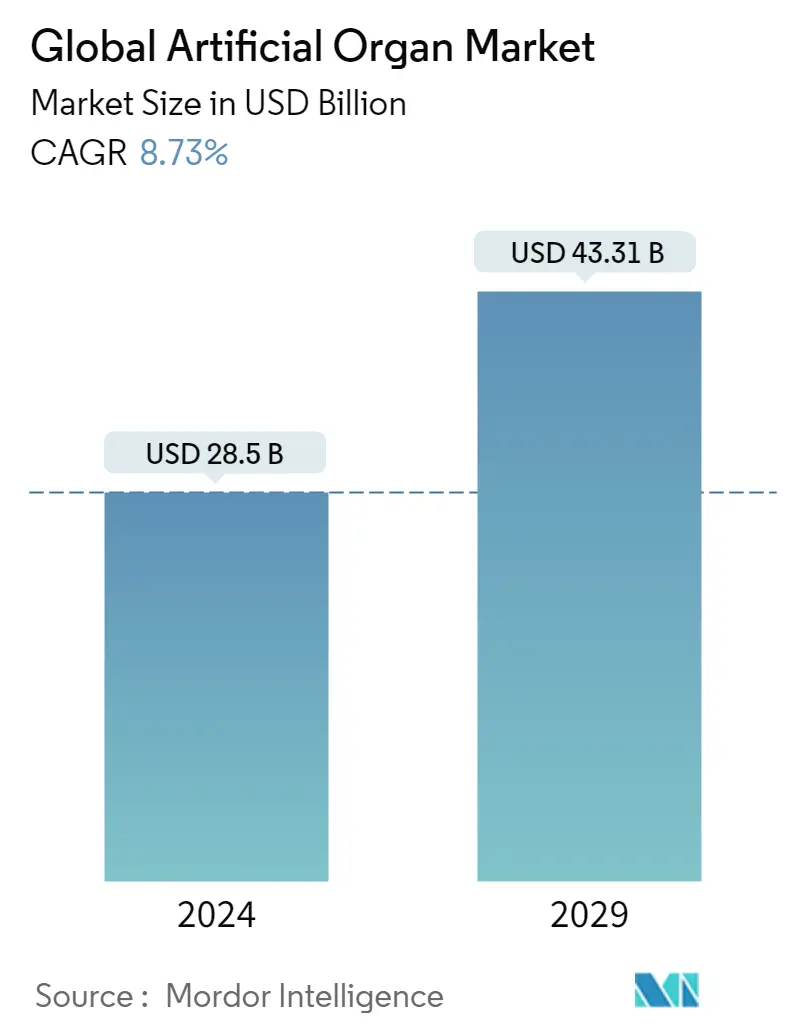
| Study Period | 2019 - 2029 |
| Market Size (2024) | USD 28.50 Billion |
| Market Size (2029) | USD 43.31 Billion |
| CAGR (2024 - 2029) | 8.73 % |
| Fastest Growing Market | Asia Pacific |
| Largest Market | North America |
Major Players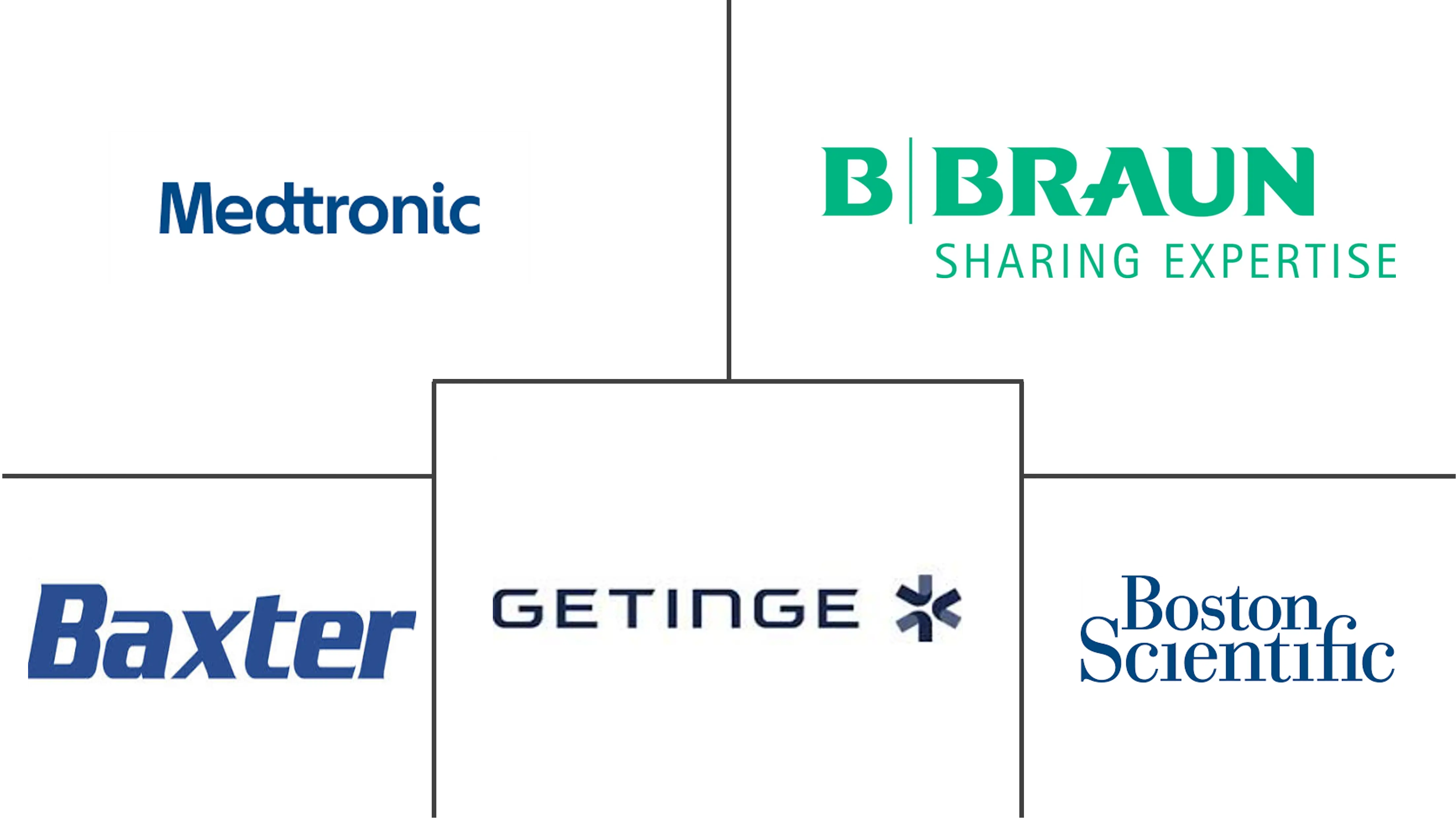
*Disclaimer: Major Players sorted in no particular order |
Artificial Organ Market Analysis
The Global Artificial Organ Market size is estimated at USD 28.5 billion in 2024, and is expected to reach USD 43.31 billion by 2029, growing at a CAGR of 8.73% during the forecast period (2024-2029).
In recent times, countries have faced a huge threat of COVID-19. According to the World Health Organization (WHO), coronavirus is an infectious disease, and most people infected with the COVID-19 virus will experience mild to moderate respiratory illness. The study 'Artificial Lung Helps Investigate How COVID-19 Causes Blood Clots,' published in October 2020, demonstrated that SARS-CoV-2 attacked the outside layer of epithelial cells embarked on a lung-on-a-chip device, just like in natural infection. Within a day, the virus had reached the inner layer of endothelial cells and caused considerable damage over subsequent days, indicating the impact of COVID-19 on the lungs. Such use of artificial lungs in research and development studies is expected to expand the scope during the study period, which will impact the market growth. Also, the study 'Impact of COVID-19 on Pacemaker Implant' published in July 2020 stated that a reduction in the pacemaker implant of 73% was observed during the COVID-19 pandemic period affecting the demand for artificial hearts, thereby impacting the market. Therefore, COVID-19 has a significant impact on the market studied.
Factors driving the market include the rising geriatric population, scarcity of donor organs, and technological advancements in the artificial organ sector.
According to an October 2021 update by the World Health Organization (WHO), by 2030, 1 in 6 people worldwide will be 60 years or above. The same source also reports that by 2050, the world's population of people aged 60 years and older will double (2.1 billion), and the number of persons aged 80 years or older is expected to triple between 2020 and 2050 to reach 426 million. As per the same source, it is now low- and middle-income countries that are experiencing the greatest change, and by 2050, two-thirds of the world's population over 60 years will live in low- and middle-income countries.
According to a study published by the British Heart Foundation in January 2022, there were approximately 7.6 million people with heart disease in the United Kingdom and nearly 160,000 deaths yearly. An average of 460 fatalities daily or one death every three minutes happen in the United Kingdom due to cardiovascular disorders (CVDs). Due to the rising burden of cardiovascular diseases, there is an increasing demand for innovative technologies which can decrease the mortality rates associated with heart failure, thereby increasing the demand for artificial hearts during the study period.
Advances in medicine and technology and increased awareness about organ donation and transplantation have contributed to a record number of transplants. Moreover, launching products in the market is a crucial factor driving market growth. For instance, in May 2020, ALung Technologies, Inc. initiated the commercial development of its next-generation artificial lung, which expands the Company's focus on highly efficient gas exchange devices and also broadens its applicable market.
Also, the article 'New Artificial Heart Shows Promising Results in 'Auto-Mode'' published in June 2021, stated that the Carmat Total Artificial Hart (C-TAH) Auto-Mode with built-in pressure sensors effectively produces appropriate physiological responses reflective of changing patients' daily needs and thus provides almost physiological heart replacement therapy. Therefore, such technological innovations in the market will fuel its growth.
Therefore, owing to the aforementioned factors, the studied market is expected to grow significantly during the study period. However, the high cost of treatment and risk associated with them is expected to hinder the market growth during the study period.
Artificial Organ Market Trends
This section covers the major market trends shaping the Artificial Organ Market according to our research experts:
Ventricular Assist Devices Subsegment Within Artificial Heart Segment is Expected to hold its Major Market Share in the Organ Type
A ventricular assist device (VAD) is a device that helps pump blood from the lower chambers of the heart (ventricles) to the rest of the body. Ventricular assist devices (VAD) are essential for patients with weakened hearts or heart failures. They temporarily maintain the heart function until it recovers or before the heart transplant. In some chronic heart conditions, they are used as permanent support therapy, as mechanical pumps surgically implanted in the heart to pump blood in the whole body.
Factors such as increasing product launches, rising research and development activities, and strategies adopted by key market players will drive the studied segment growth.
Moreover, new product approvalsand continuous government support are projected to boost the segment's growth. For instance, in February 2020, Abbott received Breakthrough Device designation from the United States Food and Drug Administration (FDA) for its in-development Fully Implantable Left Ventricular Assist System (FILVAS).
Also, in March 2021, Penn State Health Milton S. Hershey Medical Center became the second hospital in the nation to implant a newly-designed EvaHeart2 Left Ventricular Assist System (LVAS) in a patient with severe heart failure. The procedure was part of the COMPETENCE Trial, a multi-center clinical study to evaluate EvaHeart2, including 40 clinical sites and 399 patients with severe heart failure through 2022. Such transplants of advanced devices and trials proving the efficacy of the devices boost the market growth.
Thus, due to the above-mentioned factors, the studied segment is expected to contribute to the significant growth of the market.
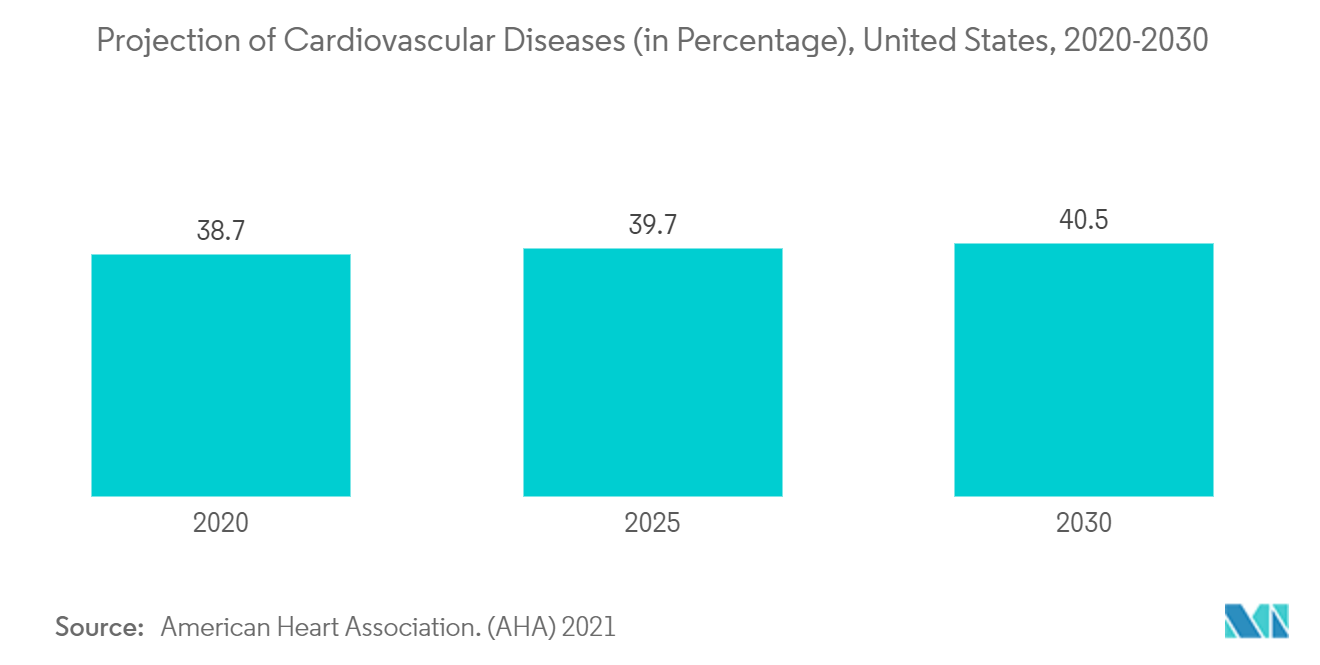
North America Dominates the Market and is Expected to Show its Dominance in the Forecast Period
North America currently dominates the artificial organ market and is expected to continue its stronghold for a few more years. The primary driving factors for the growth of the North American artificial organ market are the growing burden of chronic diseases such as heart diseases, chronic kidney diseases, pulmonary fibrosis, organ failure, and others, rising adoption of technologies, increasing product approvals, increasing investments, and key initiatives taken by the key market players.
The United States within North America is expected to grow significantly during the study period. The rising burden of cardiovascular diseases leading to heart failure is expected to boost the advancements in the artificial heart market. For instance, according to the Centers for Disease Control and Prevention (CDC)'s Article titled 'Heart Disease Facts,' updated in February 2022, Heart disease is one of the leading causes of death in the United States. The same source also reports that about 659,000 Americans have a heart attack every year. As the mortality due to heart diseases, there is a continuous need for devices that can increase the efficiency of hearts, thus driving the studied market.
Launching products and services in the region will also drive the market significantly. For instance, in October 2020, the United States Food and Drug Administration (FDA) granted 510(k) clearance to Abiomed's cardiopulmonary bypass system. This artificial lung will help treat COVID-19 patients and other people with cardiogenic shock or respiratory failure. In March 2021, Baxter received 510(k) clearance from the United States Food and Drug Administration for its portable hemodialysis machine, Artificial Kidney 98. It will help dialysis providers minimize the operational challenges that can come with administering multiple hemodialysis sessions per machine daily.
Moreover, rising research and development activities and investments are expected to propel market growth. For instance, in September 2021, The Kidney Project, a nationwide collaboration led by Shuvo Roy, Ph.D. of the University of California San Francisco, and William Fissell, MD of Vanderbilt University Medical Center (VUMC), received prize money of USD 650,000 from KidneyX for its first-ever demonstration of a functional prototype of its implantable artificial kidney. Such advancements in the artificial organ market will boost its acceptance, thus driving the market.
Therefore, due to the above-mentioned factors, the studied market is expected to lead to lucrative growth in North America.
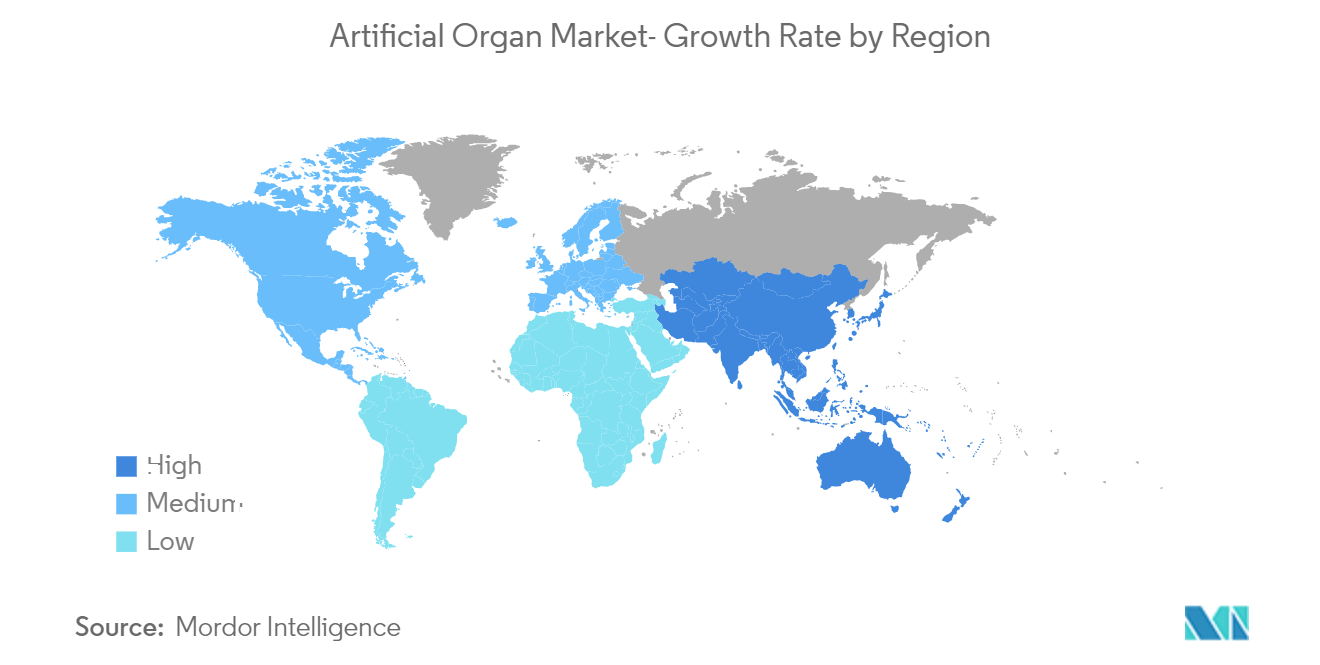
Artificial Organ Industry Overview
The artificial organ market is moderately competitive and consists of several major players. In terms of market share, few significant players currently dominate the market. However, with technological advancements and product innovations, mid-size to smaller companies are increasing their market presence by introducing new technologies at lesser prices. Companies like B. Braun Melsungen AG, Baxter International Inc., Boston Scientific Corporation, Getinge AB, and Medtronic PLC hold a substantial share in the market.
Artificial Organ Market Leaders
-
Baxter International Inc.
-
Boston Scientific Corporation
-
Getinge AB
-
Medtronic PLC
-
B. Braun Melsungen AG
*Disclaimer: Major Players sorted in no particular order
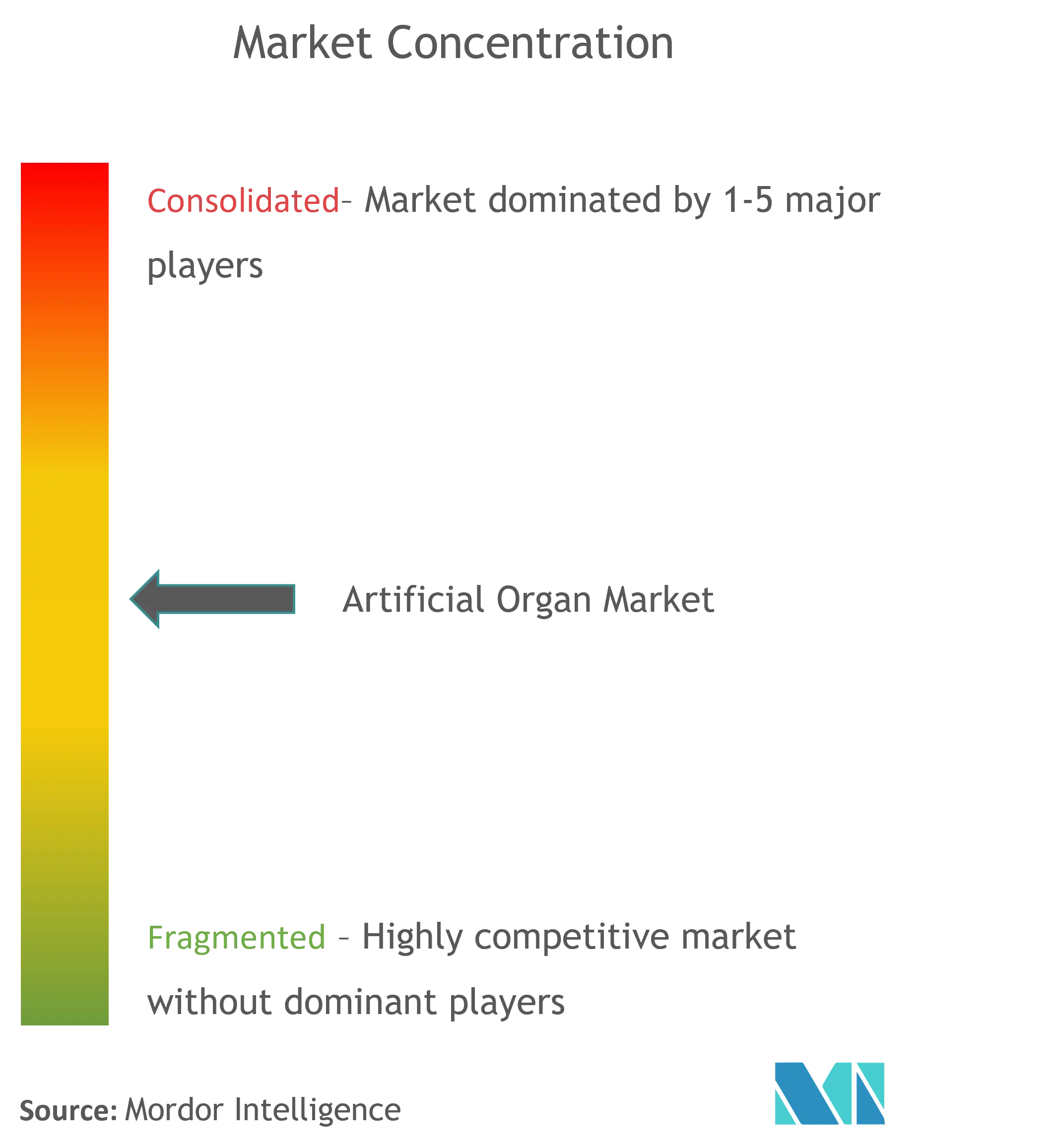
Artificial Organ Market News
- In February 2022, Vanderbilt University Medical Center, Carnegie Mellon University, and Cornell University received a four-year, USD 87 million grant from the Department of Defense Congressionally Directed Medical Research Program (CDMRP) to create the artificial lung platform, which would allow patients with incurable lung disease who can't wait for a lung transplant.
- In January 2022, the School of Medical Research and Technology (SMRT), IIT Kanpur, launched Hridyantra, a grand challenge-based program to develop an advanced Artificial Heart or a Left Ventricular Assist Device.
Artificial Organ Market Report - Table of Contents
1. INTRODUCTION
- 1.1 Study Assumptions and Market Definition
- 1.2 Scope of the Study
2. RESEARCH METHODOLOGY
3. EXECUTIVE SUMMARY
4. MARKET DYNAMICS
- 4.1 Market Overview
-
4.2 Market Drivers
- 4.2.1 Rising Geriatric Population
- 4.2.2 Scarcity of Donor Organs
- 4.2.3 Technological Advancements in the Artificial Organ Sector
-
4.3 Market Restraints
- 4.3.1 Expensive Procedures
- 4.3.2 Risks Associated With Artificial Organs
-
4.4 Industry Attractiveness - Porter's Five Forces Analysis
- 4.4.1 Threat of New Entrants
- 4.4.2 Bargaining Power of Buyers/Consumers
- 4.4.3 Bargaining Power of Suppliers
- 4.4.4 Threat of Substitute Products
- 4.4.5 Intensity of Competitive Rivalry
5. MARKET SEGMENTATION (Market Size by Value - in USD Millions)
-
5.1 By Organ Type
- 5.1.1 Artificial Heart
- 5.1.1.1 Prosthetic Heart Valves
- 5.1.1.2 Ventricular Assist Devices
- 5.1.1.3 Cardiac Pacemakers
- 5.1.2 Artificial Kidney
- 5.1.3 Artificial Pancreas
- 5.1.4 Artificial Lungs
- 5.1.5 Cochlear Implants
- 5.1.6 Other Organ Types
-
5.2 Geography
- 5.2.1 North America
- 5.2.1.1 United States
- 5.2.1.2 Canada
- 5.2.1.3 Mexico
- 5.2.2 Europe
- 5.2.2.1 Germany
- 5.2.2.2 United Kingdom
- 5.2.2.3 France
- 5.2.2.4 Italy
- 5.2.2.5 Spain
- 5.2.2.6 Rest of Europe
- 5.2.3 Asia-Pacific
- 5.2.3.1 China
- 5.2.3.2 Japan
- 5.2.3.3 India
- 5.2.3.4 Australia
- 5.2.3.5 South Korea
- 5.2.3.6 Rest of Asia-Pacific
- 5.2.4 Middle East & Africa
- 5.2.4.1 GCC
- 5.2.4.2 South Africa
- 5.2.4.3 Rest of Middle East & Africa
- 5.2.5 South America
- 5.2.5.1 Brazil
- 5.2.5.2 Argentina
- 5.2.5.3 Rest of South America
6. COMPETITIVE LANDSCAPE
-
6.1 Company Profiles
- 6.1.1 B. Braun Melsungen AG
- 6.1.2 Baxter International Inc.
- 6.1.3 Boston Scientific Corporation
- 6.1.4 Getinge AB
- 6.1.5 Medtronic PLC
- 6.1.6 Abiomed
- 6.1.7 Asahi Kasei Medical Co. Ltd
- 6.1.8 Berlin Heart GmbH
- 6.1.9 Carmat SA
- 6.1.10 Edward Lifesciences Corporation
- 6.1.11 Jarvik Heart Inc.
- 6.1.12 Terumo Corporation
- 6.1.13 ALung Technologies, Inc.
- *List Not Exhaustive
7. MARKET OPPORTUNITIES AND FUTURE TRENDS
** Subject To AvailablityArtificial Organ Industry Segmentation
An artificial organ is a medical device implanted or integrated into the body to replicate or augment the natural function of the organ. As per the scope of the report, artificial organs include implantable devices, such as entirely artificial hearts and pacemakers, along with organ support machines, such as dialysis and extracorporeal membrane oxygenation (ECMO) machines. The Artificial Organ Market is segmented by Organ Type (Artificial Heart, Artificial Kidney, Artificial Pancreas, Artificial Lungs, Cochlear Implants, and Other Organ Types) and Geography (North America, Europe, Asia - Pacific, Middle East and Africa, and South America). The market report also covers the estimated market sizes and trends for 17 countries across major regions globally. The report offers the value (USD million) for the above segments.
| By Organ Type | Artificial Heart | Prosthetic Heart Valves |
| Ventricular Assist Devices | ||
| Cardiac Pacemakers | ||
| By Organ Type | Artificial Kidney | |
| Artificial Pancreas | ||
| Artificial Lungs | ||
| Cochlear Implants | ||
| Other Organ Types | ||
| Geography | North America | United States |
| Canada | ||
| Mexico | ||
| Geography | Europe | Germany |
| United Kingdom | ||
| France | ||
| Italy | ||
| Spain | ||
| Rest of Europe | ||
| Geography | Asia-Pacific | China |
| Japan | ||
| India | ||
| Australia | ||
| South Korea | ||
| Rest of Asia-Pacific | ||
| Geography | Middle East & Africa | GCC |
| South Africa | ||
| Rest of Middle East & Africa | ||
| Geography | South America | Brazil |
| Argentina | ||
| Rest of South America |
Artificial Organ Market Research FAQs
How big is the Global Artificial Organ Market?
The Global Artificial Organ Market size is expected to reach USD 28.50 billion in 2024 and grow at a CAGR of 8.73% to reach USD 43.31 billion by 2029.
What is the current Global Artificial Organ Market size?
In 2024, the Global Artificial Organ Market size is expected to reach USD 28.50 billion.
Who are the key players in Global Artificial Organ Market?
Baxter International Inc., Boston Scientific Corporation, Getinge AB, Medtronic PLC and B. Braun Melsungen AG are the major companies operating in the Global Artificial Organ Market.
Which is the fastest growing region in Global Artificial Organ Market?
Asia Pacific is estimated to grow at the highest CAGR over the forecast period (2024-2029).
Which region has the biggest share in Global Artificial Organ Market?
In 2024, the North America accounts for the largest market share in Global Artificial Organ Market.
What years does this Global Artificial Organ Market cover, and what was the market size in 2023?
In 2023, the Global Artificial Organ Market size was estimated at USD 26.21 billion. The report covers the Global Artificial Organ Market historical market size for years: 2019, 2020, 2021, 2022 and 2023. The report also forecasts the Global Artificial Organ Market size for years: 2024, 2025, 2026, 2027, 2028 and 2029.
Artificial Organs Industry Report
Statistics for the 2024 Artificial Organs market share, size and revenue growth rate, created by Mordor Intelligence™ Industry Reports. Artificial Organs analysis includes a market forecast outlook to 2029 and historical overview. Get a sample of this industry analysis as a free report PDF download.



